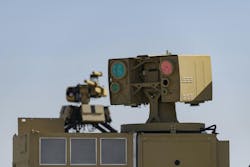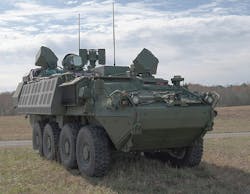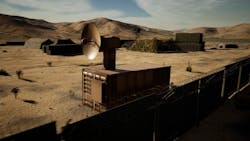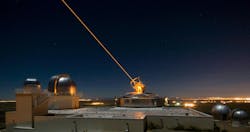Directed-energy weapons (DEWs) have left the screen and page and are entering the battlespace
Progress in laser, microwave, and other directed-energy weapons technologies is enabling militaries to deploy systems that target threats almost instantly, with virtually unlimited ammunition and precise accuracy.
U.S. and allied programs, from the Navy's shipborne HELIOS laser to the Army's Leonidas high-power microwave system, have demonstrated that these tools can complement traditional kinetic weapons, offering scalable and cost-effective solutions against drones, missiles, and other threats.
As global powers accelerate development, engineers are addressing challenges in power scaling, beam control, and thermal management while exploring applications for space-based platforms and hardened electronics. Combined with operational testing, these advances position directed-energy systems as an integral component of modern defense, reshaping both strategy and tactics.
The conflict in Ukraine has seen one of the first documented battlefield uses of directed-energy weapons (DEWs). Ukrainian and Russian forces have deployed laser weapons to counter drones, missiles, and other aerial threats, offering an early real-world test of these technologies in a contested environment.
Ukraine has unveiled its domestically developed Tryzub [Trident] laser weapon, capable of engaging uncrewed aerial vehicles, aircraft, and missiles at altitudes higher than 1.2 miles.
Ukrainian forces have used the laser weapon against Russian Shahed drones and can burn through aircraft metal in testing, says Col. Vadym Sukharevskyi, commander of Ukraine's Uncrewed Systems Forces. Tryzub shows that DEWs can carry out precise, near-instantaneous attacks on several different target types.
Russian forces also have fielded laser weapons in the conflict, including Peresvet and Zadira. Peresvet, deployed since 2019, is intended for sensor and satellite disruption, while Zadira is claimed to destroy aerial targets as far away as 3.2 miles within seconds. Publicly available information on Russian use is limited, though a video in 2025 appears to show a Russian system destroying a drone, marking one of the first confirmed combat engagements using a laser weapon in Ukraine.
These deployments underscore the increasing importance of high-energy laser technology in contemporary warfare. The Ukraine conflict is providing valuable data on the practical challenges of integrating DEWs into military operations, including targeting, power management, and coordination with traditional kinetic systems.
In ongoing operations in the Israel-Gaza conflict, Israel has fielded operational DEWs against Hamas. The Rafael Advanced Defense Systems Iron Beam system is a 100-kilowatt high-energy laser designed to intercept rockets, mortars, and drones. Unlike missiles, Iron Beam is fueled by electricity, offering significantly lower cost-per-engagement and near-instantaneous targeting.
The system has demonstrated the ability to engage several aerial threats with precision and speed, even under challenging environmental conditions. In October 2023, a prototype destroyed drones launched from Gaza.
Complementing Iron Beam, Israel has deployed the Light Blade system, which targets smaller threats such as incendiary balloons and quadcopters. Light Blade operates at ranges as far as 1.2 miles and has achieved success in intercepting these low-cost threats.
Directed-energy projects
The U.S. Department of Defense (DOD) is investing in a wide range of directed-energy projects. Programs like the Army's Palletized High Energy Laser (P-HEL) system and the Navy's High-Energy Laser with an Integrated Optical Dazzler and Surveillance (HELIOS) reflect the Pentagon's focus on rapid prototyping and quick deployment.
Both technologies aim to counter swarms of small uncrewed aerial systems and incoming projectiles. Meanwhile, research into airborne and ground-based high-energy microwave systems is expanding the use of non-kinetic effects, enabling forces to disrupt electronics and communications with minimal collateral damage.
Efforts are also underway to integrate DEWs into larger battle networks, connecting sensors, targeting systems, and command-and-control infrastructure. By combining directed-energy platforms with advanced radar, electro-optical, and electronic warfare sensors, operators can detect, track, and engage threats in real time.
As these technologies develop, military planners are exploring operational concepts that harness the speed, precision, and scalability of DEWs to support layered defense strategies - from protecting high-value assets to enabling expeditionary operations in contested environments.
Army efforts
Built for quick, accurate targeting of aerial and ground threats, P-HEL combines high-power laser technology with advanced targeting and beam control. Recent tests have aimed at neutralizing swarms of small drones and defending against rocket, artillery, and mortar threats, showing the system's potential to enhance traditional defenses and decrease the logistics of using conventional munitions.
During demonstrations, P-HEL effectively engaged several small UAS' at different distances, showing both its precise targeting algorithms and beam stabilization technologies. The system uses modular laser modules that can adjust their output to respond to various threat types, providing a versatile response while managing thermal loads and power requirements. Army officials say P-HEL is designed for near-term integration into existing tactical vehicles and forward operating bases, with ongoing tests evaluating its reliability, maintenance requirements, and compatibility with sensor networks for real-time threat detection.
In February 2024, the Army deployed four Directed Energy Maneuver-Short Range Air Defense (DE M-SHORAD) prototype vehicles overseas, delaying scientific and technical testing originally planned by the Rapid Capabilities and Critical Technologies Office (RCCTO). During the deployment, the Army Test and Evaluation Command conducted a three-day controlled assessment in June; however, officials noted that the limited data was insufficient for a comprehensive evaluation of the system's effectiveness, lethality, suitability, and survivability. Operational insights are instead being gathered through an ongoing In-Theater Assessment.
The DE M-SHORAD integrates sensors and a 50-kilowatt spectral beam combined laser onto a Stryker Mortar Carrier Double V-Hull A1 armored combat vehicle. Powered by lithium nickel cobalt aluminum oxide (Li-NCA) batteries recharged by onboard diesel generators, the system is designed to counter uncrewed aircraft systems, rockets, artillery, mortars, and rotary- and fixed-wing aircraft. Organized into platoons of four vehicles within short-range air defense battalions, the laser-armed Strykers are intended to complement M-SHORAD vehicles equipped with kinetic weapons such as Stinger missiles and a 30-millimeter cannon.
In June, soldiers from the 4th Battalion, 60th Air Defense Artillery Regiment worked with the Army's Rapid Capabilities and Critical Technologies Office (RCCTO) to conduct a live-fire exercise pairing DE M-SHORAD with traditional kinetic platforms at Fort Sill, Okla. The event focused on defeating swarms of Group 1-3 uncrewed aircraft systems while exploring how lasers and missiles can function together in a layered defense. The exercise provided key data to guide future development and procurement, particularly the Army's 2026 Enduring High Energy Laser program, expected to become the first DE program of record.
The Fort Sill test also allowed soldiers to practice refined tactics, techniques, and procedures for integrating lasers into air defense operations, including threat prioritization, identification protocols, and engagements under varying environmental conditions.
High-power microwaves
Alongside its high-energy laser initiatives, the U.S. Army is investing in electromagnetic weapons that include high-power microwave (HPM) systems to counter emerging aerial threats. One of the more prominent efforts is the Leonidas program, an electromagnetic weapon developed by Epirus Inc. in Torrance, Calif. Designed as a counter-uncrewed aircraft system (C-UAS), Leonidas delivers pulsed bursts of electromagnetic energy to disable or destroy the electronics inside drones and other airborne threats without the need for kinetic interceptors.
The system is built around solid-state, software-defined HPM technology that enables operators to tailor its effects against swarms of targets in real time. Unlike traditional jamming systems that rely on brute-force broadcasting across frequency bands, Leonidas uses precision-targeted waveforms to create localized, high-intensity electromagnetic effects. This approach is intended to minimize collateral impact on friendly systems while enabling scalable power output for different operational environments.
The RCCTO has tested Leonidas in live-fire events to demonstrate how it fits within a layered defense. In 2024, the system was evaluated against Groups 1 through 3 uncrewed aircraft in swarming attack profiles, with the goal of validating its ability to neutralize several threats simultaneously. According to Army officials, the technology is being integrated onto tactical vehicles to assess mobility, survivability, and interoperability with command and control systems.
Navy power
The Navy's High Energy Laser and Integrated Optical-dazzler with Surveillance (HELIOS) program aims to provide shipboard defense against drones, small boats, and aerial threats. Developed by Lockheed Martin in Bethesda, Md., HELIOS features a modular high-power laser integrated with shipboard radar, electro-optical sensors, and fire-control systems. Testing has included live-fire evaluations aboard vessels to validate targeting software, beam control, and thermal management.
According to the Department of Defense's Director, Operational Test and Evaluation (DOT&E) reports, HELIOS testing continues to evaluate system performance in realistic maritime conditions, focusing on reliability, integration with shipboard combat systems, and effectiveness against several uncrewed threats simultaneously.
Beyond terra firmThe U.S. Air Force is advancing its own directed-energy portfolio through efforts like the Tactical High Power Operational Responder (THOR), a counter-drone system developed by the Air Force Research Laboratory (AFRL) at Kirtland Air Force Base, N.M.
THOR uses high-power microwaves to disable or destroy the electronics inside small UAS, providing a fast, non-kinetic option for base defense. Housed in a standard shipping container and designed for rapid deployment, THOR can be transported aboard a C-130 aircraft and can be set up in less than three hours. The system's wide-beam emission allows operators to engage swarms of drones simultaneously.
Beyond tactical systems, the Air Force and the U.S. Space Force are exploring how directed energy could support future space control missions. AFRL's Directed Energy Directorate has conducted studies on ground-based lasers for satellite dazzling, advanced imaging, and orbital defense applications. These efforts are tied to broader research on power scaling, beam control, and atmospheric propagation that would be required for any potential space-based laser or microwave platform.
While much of this work remains at the modeling and feasibility stage, AFRL and the Defense Advanced Research Projects Agency (DARPA) have examined megawatt-class space power systems and lightweight optics as enablers of orbital directed energy capabilities. The long-term vision is to develop tools that can protect satellites, deny adversary space capabilities, and integrate directed energy into layered space security architectures.
Allied efforts
The United Kingdom (UK) also is advancing its directed-energy portfolio through the DragonFire laser-directed energy weapon (LDEW) program. In a recent trial at the Ministry of Defence's (MOD) Hebrides Range, the system achieved the nation's first high-power laser firing against aerial targets, marking a step toward the UK fielding the technology in the future. While the exact range remains classified, DragonFire is a line-of-sight weapon capable of engaging any visible target, with the precision "equivalent to hitting a £1 coin from a kilometer away," according to program officials.
Led by the Defence Science and Technology Laboratory (DSTL) on behalf of the MOD, with industry partners MBDA in Le Plessis-Robinson, France, Leonardo in Rome, and QinetiQ in Farnborough, UK, DragonFire is the product of a £100 million joint investment. Its design emphasizes both accuracy and affordability, with each shot costing less than £10 - what officials describe as the energy equivalent of running a household heater for an hour.
"This type of cutting-edge weaponry has the potential to revolutionize the battlespace by reducing the reliance on expensive ammunition, while also lowering the risk of collateral damage," said Defence Secretary Grant Shapps. Dstl Chief Executive Dr. Paul Hollinshead added that the trials represent "a huge step forward in realizing the potential opportunities and understanding the threats posed by directed energy weapons."
The British Army and Royal Navy are considering DragonFire for integration into future air defense architectures, building on MOD-backed research that began with a 30 million-pound contract in 2017. Officials emphasize that accelerating the transition from the laboratory to operational service will be a priority in the next phase of development.
Testing needs
While U.S. military branches have "ready for primetime" systems at their disposal, testing DEWs comes with its fair share of headaches. The DOT&E is the DOD's office responsible for independently assessing whether new military systems perform as intended in realistic operational conditions.
DOT&E oversees operational testing, evaluates effectiveness, suitability, and survivability, and reports findings to Congress to support acquisition decisions. The office focuses on ensuring that weapons, platforms, and technologies - ranging from aircraft and ships to integrated air and missile defense systems - can operate reliably alongside existing capabilities, providing an independent check that helps mitigate risk and ensure warfighters receive systems that are both effective and safe.
Earlier this year, DOT&E noted in its annual report that the DOD currently lacks the infrastructure to test high-energy lasers and other directed energy weapons under realistic operational conditions. Existing facilities - including the Army's White Sands Missile Range - are limited to single-system tests and cannot support integrated, multidomain evaluations of air, land, and sea platforms. Range constraints, safety requirements, and cost limitations further restrict the amount of live testing that is practical.
DOT&E reported that key gaps include a shortage of credible threat surrogates for anti-ship missiles, drone swarms, and other peer-level systems, as well as insufficient instrumentation to capture radar, infrared, and electromagnetic signatures needed to assess performance and validate models. The inconsistent collection of time, space, and position information across platforms complicates post-test analysis and makes it difficult to reconstruct engagement results.
The evaluation office says that DOD increasingly relies on modeling and simulation, including Open-Air Battle Shaping (OABS), to simulate mission-level engagements. While these tools help fill gaps, their fidelity depends on improvements in instrumentation, network connectivity, and expanded threat representation.
DOT&E stresses that fully evaluating directed energy systems requires sustained investment in test range modernization, DE-specific safety equipment, high-fidelity threat surrogates, and a skilled test and evaluation workforce capable of handling emerging technologies such as lasers, high-power microwaves, and electromagnetic warfare systems.
"The electromagnetic operating environment (EMOE) is increasingly congested and contested by military and civilian systems and constrained by national and international regulations. In addition, modern software-defined EMS-dependent systems can rapidly change their operating characteristics," DOT&E said in its annual report. "Future adversary EMS dependent systems will include complex, autonomous behavior (incorporating AI to varying degrees) that will adapt to changing environments as the systems learn.
The report continues, "The inability to represent modern radars affects T&E of EW systems and their associated combat systems and platforms. Emulating the closed-loop tracking capabilities of modern threat radars, including software-defined radars, remains a shortfall. This shortfall critically affects the ability to conduct adequate operational testing of our Electronic Attack (EA) capabilities. Additionally, it affects the ability the test EA capabilities to support their host platforms' mission. Most of the radar emulation capabilities on the test ranges and in laboratory facilities emulate only the open-loop signal emissions of threats, and not the sophisticated back-end processing, including electromagnetic protection logic, that these radars employ. Other key EMS-related shortfalls are focused on our emulation of threat electromagnetic attack systems. For example, the current set of anti-ship missile surrogate (aerial target) payloads do not sufficiently represent foreign electromagnetic attack systems for use in testing a program's electromagnetic protection. While the Navy has improved their ability to represent such threats, advancements in these capabilities have not yet been fully integrated into aerial targets. This issue affects all variants of shipboard air and missile defense systems, and host platforms. Another key shortfall is in the ability to conduct frequent and simultaneous GPS jamming and spoofing across several test ranges, at times due to FAA regulations."
Near-peer developments
China's military research community is reporting progress on a new class of HPM weapons designed to disable or destroy the electronics inside adversary systems. Stephen Chen originally reported the development for the South China Morning Post, citing a peer-reviewed study in High Power Laser and Particle Beams by scientists from the National University of Defence Technology in Changsha and the Northwest Institute of Nuclear Technology in Xian.
Unlike traditional HPM systems, which rely on rotating dish antennas to target threats, the Chinese design employs phased-array transmission to focus energy more precisely. Researchers claim this approach not only extends the weapon's effective range but also allows simultaneous engagement of several targets. One of the reported breakthroughs is an eight-way power divider that maintained stable output during more than 5,000 full-power emissions, operating at efficiency levels above 96 percent.
The electromagnetic waves generated by the system reportedly reach power levels of nearly one gigawatt, with electric field strengths comparable to those of nuclear-induced electromagnetic pulses. Testing also demonstrated the ability to emit in the Ku-band, the same frequency range used by commercial satellite constellations such as SpaceX's Starlink communications technology. Some Chinese experts note that the reliance on commercial-grade components in these constellations could leave them vulnerable to such directed-energy attacks.
The research underscores Beijing's interest in anti-satellite and counter-space capabilities. With Starlink's role in supporting Ukrainian defense against Russia, Chinese analysts suggest that gigawatt-class HPM systems could be developed as tools for targeting drones and satellites in low-Earth orbit, raising the prospect of new challenges in space and electronic warfare.
About the Author
Jamie Whitney
Senior Editor
Jamie Whitney joined the staff of Military & Aerospace Electronics in 2018 and oversees editorial content and produces news and features for Military & Aerospace Electronics, attends industry events, produces Webcasts, and oversees print production of Military & Aerospace Electronics.






